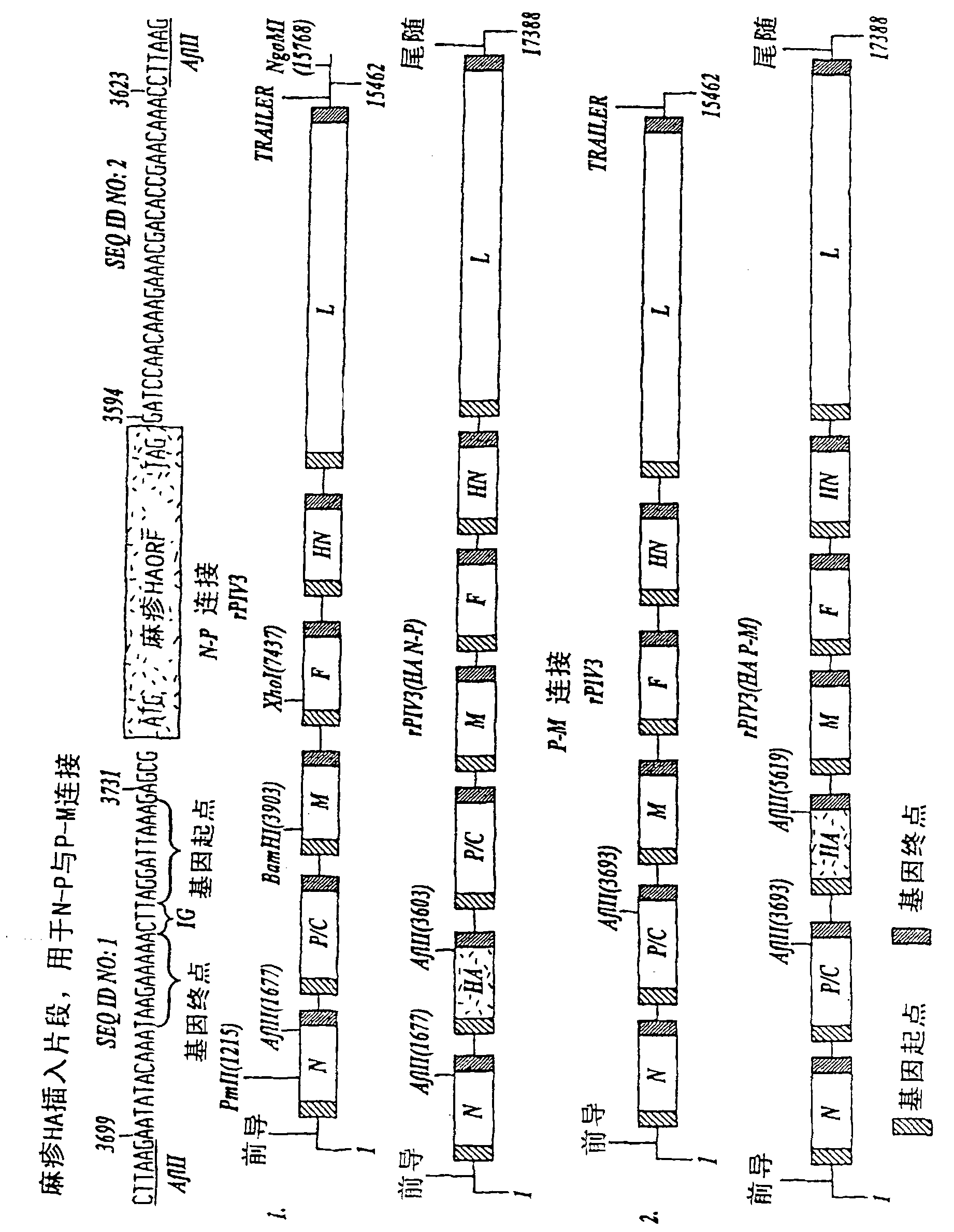Use of recombinant parainfluenza viruses (PIVs) as vectors to protect against infection and disease caused by PIV and other human pathogens
A parainfluenza, virus technology, applied in the direction of virus antigen components, virus/phage, introduction of foreign genetic material using vectors, etc.
- Summary
- Abstract
- Description
- Claims
- Application Information
AI Technical Summary
Problems solved by technology
Method used
Image
Examples
Embodiment I
[0220] Construction of cDNA encoding a chimeric PIV3 / measles virus-HA antigenome and acquisition of infectious virus
[0221] A full-length cDNA clone, p3 / 7(131)2G, has been described previously + , which encodes the complete 15462 nucleotide antigenome of the JS PIV3wt virus, and pFLCcp45L, which encodes the antigenome of a JS wt derivative containing three cp45-specific temperature-sensitive mutations in the L ORF of PIV3 (Durbin et al., Virology 235 : 323-332, 1997a; Skiadopoulos et al., J. Virol. 72: 1762-8, 1998, incorporated herein by reference). These clones were used as vectors for insertion of the HA gene of measles virus to generate wild-type and attenuated HPIV3 chimeric constructs expressing heterologous epitopes such as the HA protein of measles virus. The size of each insert containing the measles HA gene is a multiple of 6, allowing chimeric viruses derived from cDNA to conform to the 6 rule (Durbin et al., Virology 234:74-83, 1997b, incorporated herein by refe...
Embodiment II
[0240] Chimeric rPIV3 containing measles virus epitopes replicates efficiently in hamsters and induces high titers of anti-HPIV3 and anti-measles antibodies
[0241] Determination of Replication and Immunogenicity of rPIV3(HA) Virus in Hamsters
[0242] The level of replication of chimeric rPIV3 containing measles virus epitopes was compared to that of its parental rPIV3 to determine whether the acquisition of determinants such as HA inserts significantly altered its ability to replicate and induce an immune response in vivo. In two different experiments, 0.1 ml of 10 6.0 EMEM (Life Tchnologies) of rJS, rcp45L, rcp45L(HAP-M), rcp45L(HA N-P), rPIV3(HA HN-L) or rPIV3(HA P-M) of PFU (Table 2 and Table 3). On day 4 after inoculation, the hamsters were sacrificed, and the lungs and turbinates were removed. Turbinates and lungs were homogenized in 10% and 20% w / v L-15 (Quality Biologicals, Gaithersburg, MD) suspensions, respectively, and samples snap frozen. Viruses present in th...
Embodiment III
[0271] Construction of an antigenomic cDNA encoding a chimeric HPIV3-1 vector containing the HPIV2 HN gene as an external transcription / translation unit inserted between the F and HN genes, and acquisition of infectious virus
[0272] rPIV3-1 is a recombinant chimeric HPIV3 in which the HN and F genes are replaced with those of HPIV1 (see, e.g., Skiadopoulos et al., Vaccine 18:503-510, 1999; Tao et al., Vaccine 17: 1100-1108, 1999; U.S. Patent Application Serial No. 09 / 083,793, filed May 22, 1998; U.S. Patent Application Serial No. 09 / 458,813, filed December 10, 1999; U.S. Patent Application Serial No., filed December 10, 1999 No. 09 / 459,062, both of which are incorporated herein by reference). In this example, the HN gene of HPIV2 was inserted into the rPIV3-1 chimeric virus, which was used as a vector for generating chimeric derivative viruses, containing introduced heterologous antigenic determinants from HPIV2, capable of producing protection against HPIV1 and HPIV2. The ...
PUM
 Login to View More
Login to View More Abstract
Description
Claims
Application Information
 Login to View More
Login to View More - R&D
- Intellectual Property
- Life Sciences
- Materials
- Tech Scout
- Unparalleled Data Quality
- Higher Quality Content
- 60% Fewer Hallucinations
Browse by: Latest US Patents, China's latest patents, Technical Efficacy Thesaurus, Application Domain, Technology Topic, Popular Technical Reports.
© 2025 PatSnap. All rights reserved.Legal|Privacy policy|Modern Slavery Act Transparency Statement|Sitemap|About US| Contact US: help@patsnap.com



